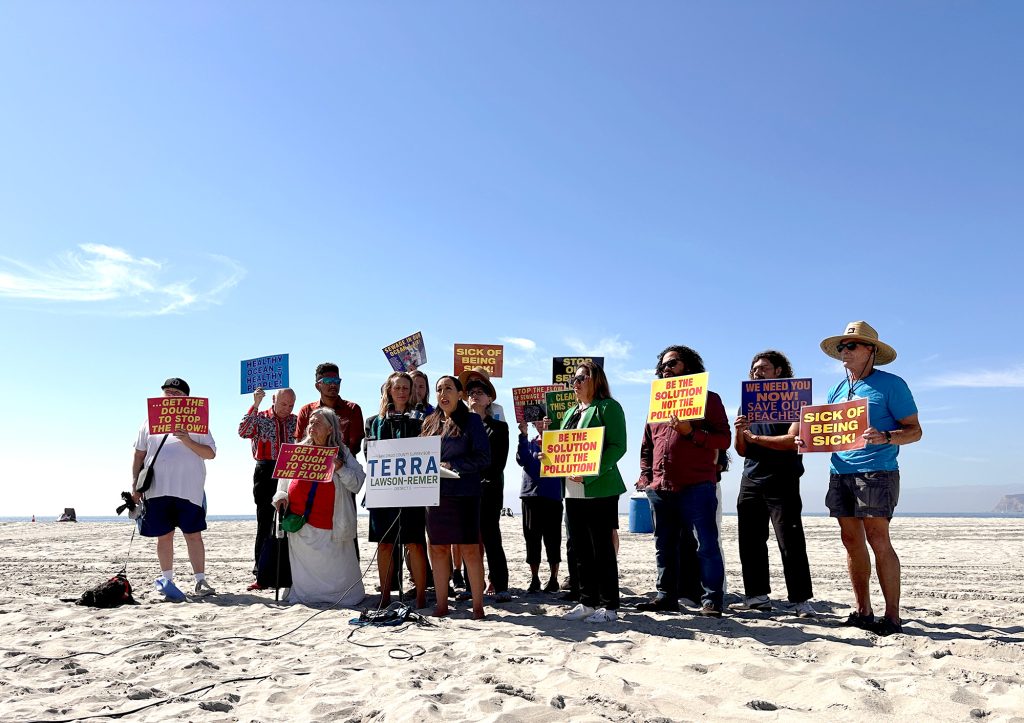
Terra Lawson-Remer is on a mission to investigate the Tijuana River Valley as a potential Superfund site.
“For eight decades, we know that this river valley has been contaminated with sewage, toxic chemicals, industrial waste, heavy metals, banned pesticides, and more,” she said at an Oct. 8 meeting of the San Diego Board of County Supervisors. “So even after we fix this sewage discharge problem, and even if the air is cleaner to breathe, there could very well be waste buried in the sediment that could bubble up and harm our communities.
Lawson-Remer said investigating this is an important, yet missing, piece to addressing the sewage crisis. It should be done concurrently with the more immediate-focused work that is underway to repair the failing infrastructure that causes it and to distribute air filters to those living in San Diego’s South Bay, she said.
Lawson-Remer first asked the San Diego Board of Supervisors to request that the Environmental Protection Agency investigate the Tijuana River Valley as a potential Superfund site. In a 3-2 vote, the board decided to delay a decision by 90 days so its members could further analyze the notion.
In the meantime, Lawson-Remer and other county leaders brought that mission to Coronado Beach on Oct. 24, where 500 residents signed a petition asking for superfund designation and submitting stories of how the crisis has impacted them.
She was joined by Laura Wilkinson-Sinton, a candidate for Coronado City Council and founder of Stop the Sewage, who spoke at the event. Other Coronado political figures in attendance were Christine Mott and Alexia Palacios Peters.
A Superfund site is a contaminated area designated and remediated by the EPA. The program was established by the Comprehensive Environmental Response, Compensation, and Liability Act of 1980, but is colloquially known as “Superfund.”
The law allows the EPA to clean up contaminated sites. Parties responsible for the contamination are financially liable, and must either clean the sites themselves or reimburse the government for doing so. The goal is to return contaminated sites to productive use.
Notable Superfund sites include the Clark Fork River Superfund Complex, the largest and most expensive site to date, the Stringfellow Acid Pits in Riverside, Calif., and the Pensacola Naval Air Station in Pensacola, Fla.
County board members said that while the millions of gallons of untreated sewage being dumped into the Pacific Ocean daily is a catastrophe, they were unsure whether the designation would help – or even hurt – solving the problem.
Board Chair Nora Vargas said she supported the spirit of the petition, calling the sewage crisis the consequences of decades of neglect that must be fixed. However, she moved to delay a superfund decision by 90 days to allow more time for research.
“A superfund is a lengthy and highly complex process,” she said during the meeting. “It could take decades before any meaningful cleanup begins.”
Because it can take so long, Vargas said, she worried that entering the process might delay repairs to the infrastructure causing the problem that is already long overdue. She also questioned if the designation would hurt property values in the South Bay and whether a superfund designation would even be appropriate, considering that the Tijuana sewage crisis is an international matter. She said she was not saying no; she simply wanted to look into the matter more.
Lawson-Remer, however, saw it differently. She applauded repair projects and air filter disbursements already underway, but said investigating potential long-term pollution was a third project that needed attention.
“Cleaning up this legacy of hazard pollution in the river is, I believe, potentially one of the biggest environmental justice challenges that we face in San Diego County in this generation,” Lawson-Remer said.
The Government Accountability Office reports that Superfund sites in the past have taken about a decade to remedy. The process is, according to the EPA’s own website, lengthy.
But Lawson-Remer said the county needs to solicit the funds available to clean up any potential lingering contaminants in the soil after construction on the projects stopping the flow of wastewater are complete.
“We are not, and I am not saying at this time that we know that the contaminants are at a dangerous level within the Tijuana River Valley,” she said.
But she wants the EPA to do an inspection and determine, based on a hazard ranking score, whether the site could be placed on the National Priorities List (NPL).
Consideration of a Superfund designation, she said, should be done concurrently with stopping the sewage flow.
Exactly 500 people signed the letter sent last week to the EPA Region 9 Administrator Martha Guzman.
“I have lived and enjoyed the ocean in Coronado for 70 years,” said Steve Nystul in his remarks on the petition, “and this has been devastating to my health and my family’s lives. I can no longer enjoy surfing and swimming at my beloved beach.”




